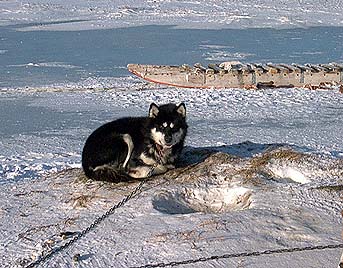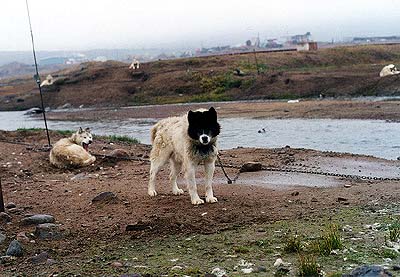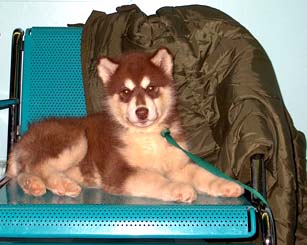Table of Contents
Featured Inuit Dog Owners:
Scott & Terry Miller
Nunavut Dogsledding Association
Update: No Resolution in Iqaluit
Season's Greetings from Toadhall
The Homecoming, Part II
The Russian Connection, Part II
Meeting Ken Pawson and Kevin Walton
Arctic Sojourn
The Ted Fox ISDI Foundation Fund
Book Review:
Two Years in Antarctica
Janice Howls:
No Click and Treat for ISDs!
IMHO:
All Breed Kennel Club Registry
Navigating This
Site
Index of articles by subject
Index
of back issues by volume number
Search The
Fan Hitch
Articles
to download and print
Ordering
Ken MacRury's Thesis
Our
comprehensive list of resources
Talk
to The Fan
Hitch
The Fan
Hitch home page
ISDI
home page
Editor: Sue Hamilton
Webmaster: Mark Hamilton
Contents of The Fan Hitch Website and its publications are protected by international copyright laws. No photo, drawing or text may be reproduced in any form without written consent. Webmasters please note: written consent is necessary before linking this site to yours! Please forward requests to Sue Hamilton, 55 Town Line Rd., Harwinton, Connecticut 06791, USA or mail@thefanhitch.org

On the picket line in Iglulik Montcombroux photo
Arctic Sojourn
by Geneviève Montcombroux
This year, I was privileged to visit the Nunavut communities of Resolute Bay, Iglulik and Iqaluit.
In Resolute Bay, I counted Canadian Inuit Dogs. A dismal picture. only one out of six was a pure ISD. How long will these few be able to breed pure? Aziz and Aleasuk Kheraj offered me the greatest hospitality at their South Camp Inn lodge. Walking on the gravel beach watching the tide bring in small floes of wind-shaped ice, it was easy to imagine the ships that passed this very shore on their quest for the Northwest Passage. Aleasuk is very conscious of the dog situation and would like to see more young people using dogs. She recognizes that the pure ISD is superior to the crosses, but finds it difficult to acquire pure specimens.
Next stop was Iglulik where I stayed at the family run Turjormivik Hotel with its friendly atmosphere. In Iglulik, I found more traditional hunters who are using pure ISD. But in the words of Apayata Kokierk, "It is very difficult to keep the dogs (pure) because of the white man's dogs." Pride and care are not enough to prevent the roaming German Shepherds or Rottweilers to breed a female tied to her picket line. All the young people I talked to here were very excited about the Nunavut Quest sled dog race. Unlike southern races, one rule of the Quest is that teams have to be run in the traditional manner, i.e. a qamutik and the dogs in a fan hitch. Participants have to live off the land and are pretty much on their own. It calls for traditional traveling skills. Young Timen Avingak talked proudly of his father and his dogs. He would like to enter the race but has no dogs of his own. He had, however, many questions. His friend Matthew's eyes were full of dreams and pride when he related how his grandfather used to run dogs and would take him along when there were tourists wanting to go on sled dog excursion. He talked much about the race and even invited me to come with my dogs to enter the Nunavut Quest. He hopes that one day he can own a team.
Roaming dogs, and they are almost exclusively southern breeds, are the bane of Iqaluit. The ISD team dogs sometimes get loose, but they tend to stay with their team mates still picketed on the line, that is unless a roaming female in heat comes so close to a team, that a male will do its utmost to get free. The carelessness of so many owners who allow their dogs to run free has caused grief to dog team owners. At a time when Nunavut has adopted the Canadian Inuit Dog as the official mammal emblem, the city of Iqaluit is trying to get rid of ISD teams. Are the authorities trying to turn Iqaluit into a southern capital? It would seem that they ought to be reinforcing the cultural identity of Nunavut. The powers-that-be should think about what the impact Canadian Inuit dog teams, or lack thereof, would have on tourism, which is the main industry of the Territory.
I suggest that the Nunavut government move to protect the last aboriginal dog breed of Canada by enacting a law requiring any dog of a southern breed coming to, or already residing in, a Nunavut community to be neutered/spayed. Then maybe in time, the Canadian Inuit Dog could be restored in sustainable numbers to the land where it rightfully belongs and from where it originated.

Montcombroux photo
Acknowledgments
I would like to thank the sponsors who made possible two trips to the Baffin Region to begin a survey of the CISD in various Arctic communities. In addition to the scientific data gathered during the visit is a beautiful female pup, "Lulik", who is a great addition the ISDI Foundation stock.
Joan
Lewin, from Ontario, Canada
Jerry
and Sharon Roberts, from Ohio, USA
Barry
Salovaara, from Ontario, Canada
Susan
Wells, from Florida, USA
Geneviève

Montcombroux photo
Six week old Lulik waiting at the Iglulik airport